
Leucozona lucorum is a Palearctic and Nearctic species of hoverfly.

Platycheirus immarginatus, the Comb-legged Sedgesitter, is a common species of hoverfly. It is found in parts of northern Europe and northern North America.
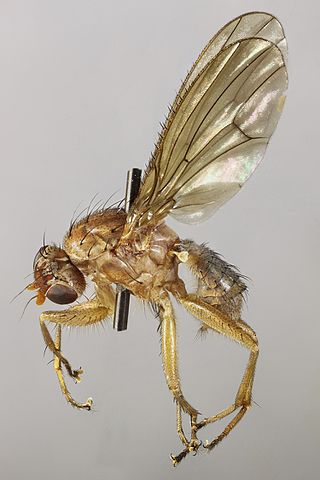
Suillia bicolor is a Palearctic species of Heleomyzidae. The sctellum is covered with light, fine, scattered hairs. The wing venation is characterized by the presence of small spines on the costal vein. The first pair of legs of the male has the first tarsal segments equipped with a spike of a triangular shape and a width smaller than the width of the segment. The female's abdomen has a seventh segment that is longer than the sixth. The reproductive organs of females have three irregularly jagged, cylindrical in outline, seminal receptacles narrowly curled at the apex. For terms see Morphology of Diptera.

Sepedon sphegea is a Palearctic species of fly in the family Sciomyzidae, the marsh flies or snail-killing flies. The larva feeds on aquatic snails and as an opportunist on other invertebrates. The habitat of this species includes among many others, pond margins and damp meadows. It has a particular fondness for Iris pseudacorus which grow at the edges of the pond. Adults can be found all year long but the main flight period is from March to October.
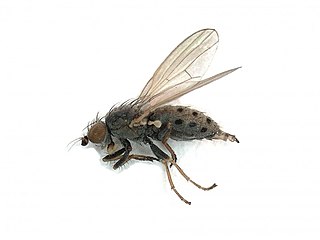
Chamaemyia flavipalpis is a species of fly in the family Chamaemyiidae. It is found in the Palearctic. and North Africa.
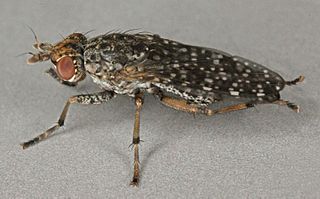
Dictya umbrarum is a species of fly in the family Sciomyzidae. It is found in the Palearctic and Nearctic. Long. : 4-5 mm. Intensely spotted wings.The interocular space with a black mark at the anterior orbital.The face is white with a black or brown central point. The antennae are reddish, the arista yellow at the base.The body is black covered in a grey yellow pruinosity with shifting (changeant) brown spots on the abdomen.The femora are grey with a brown apical band.The tibia are yellow with a brown apical ring (anneau). For terms see Morphology of Diptera. Dictya montana is a predator of aquatic pulmonate snails with no apparent parasitoid tendency.

Elgiva cucularia is a species of fly in the family Sciomyzidae. It is found in the Palearctic .Long. : 5-8 mm.Overall it is coloured yellowish-brown with a bluish-gray body. The head is characterized by silky black dots at the bases of the anterior orbital setae, between the bases of the antennae and the edges of the compound eyes, and in the centre of the occiput. The third antenna segment is a little shorter than the second. The mesonotum is black with a grey ground and grey pruinosity.There are longitudinal, brown stripes on the dorsum of the thorax: two narrow in the middle and two wide on the sides. One mesopleural bristle amongst short setae.The prothorax is bare. The yellowish smoky wings are 5.2 to 6.8 mm long and have fuzzy spots on the front half. The legs and abdomen are yellow. The lower surfaces of the hind femora are equipped with setae, while the front pair lacks them.The abdomen is rufous.For terms see Morphology of Diptera. Larvae of E. cucularia are predators of aquatic, pulmonate snails in the families Lymnaeidae, Physidae, and Planorbidae.
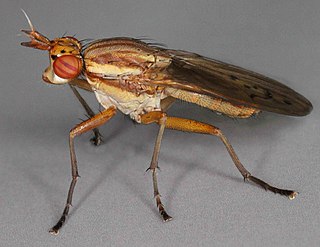
Ilione albiseta is a species of fly in the family Sciomyzidae. It is found in the Palearctic .The body length is 8 to 11.2mm and the basic colour is yellowish-brown. The spot on the occiput, the spots at the base of the frontal orbital setae and the almost triangular spots at the edge of the eyes at the height of the antennae are silky dark brown. The long antennae have a whitish hairy arists. There are longitudinal, brown stripes on the yellowish-dustedmesonotum : two narrow in the middle and two wide on the sides. In addition, there is a brown band on the body below the notopleura. The prosternum is bare. Chaetotaxy of the thorax shows strong presutural acrostichal setae and 2–3 well-developed subalar setae. The wings are 6.8 to 8 mm long and usually have 5 marks: on the anterior transverse vein, the medial vein, and the two ends of the posterior transverse vein. If there are only 2 dots on the medial vein, the transverse veins are at least darkened. The legs are yellow with darkened tarsi. The lower surfaces of the femora of the hind legs are equipped with strong and dense setae in males, and with short and sparse setae in females. Males are characterized by a copulatory apparatus with non-swollen abdominal pituitary glands.For terms see Morphology of Diptera. The larva preys on Galba truncatula

Limnia unguicornis is a species of fly in the family Sciomyzidae. It is found in the Palearctic.
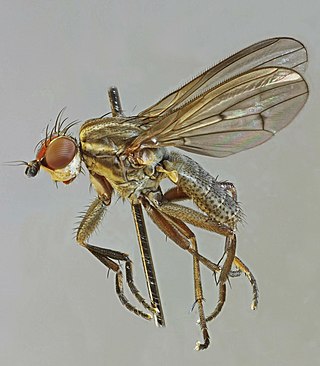
Pherbellia cinerella is a species of fly in the family Sciomyzidae. It is found in the Palearctic. P. cinerella is a dark and very characteristic Pherbellia and easy to recognise in the field by its long mid-frontal stripe and darkened anterior wing margin. The larva is predatory on a variety of terrestrial and aquatic snails including Helicidae, Galba truncatula, Helix, Helicella, Succinea and Lymnaea.There is little or no host preference. It is found in a wide range of habitats but it is most often found in warm and dry habitats such as coastal dunes and calcareous grassland where it can reach high numbers. It is also encountered in moist vegetation though in lesser numbers. It is a potential biological control agent.
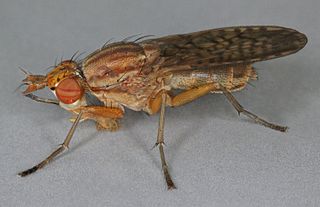
Pherbina coryleti is a species of fly in the family Sciomyzidae. It is found in the Palearctic . A large, largely yellowish and common species of snail-killing flies. Both sexes have heavily shaded wings.The genital armature of males has gonostyli with a tuft of hairs. The larvae are aquatic and predators of freshwater snails.

Pherbellia ventralis is a species of fly in the family Sciomyzidae. It is found in the Palearctic. Pherbellia ventralis is a small sciomyzid. The body is dark grey blue to blue grey contrasting with the yellowish brown abdomen.The mid-frontal stripe is short. The larvae feed on aquatic snails including Stagnicola palustris.

Pteromicra angustipennis is a species of fly in the family Sciomyzidae. It is found in the Palearctic. It is a small sciomyzid with 1 + 2 dorsocentral bristles.The transverse veins of the wings have no shadows but they are distinctly shaded at the apex. The larvae predators of terrestrial snails or stranded freshwater pulmonate snails.
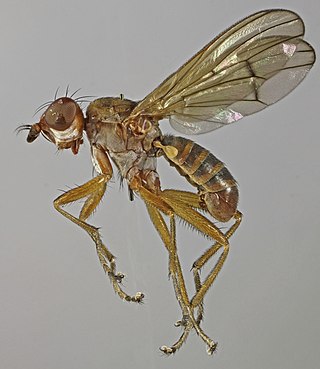
Renocera pallida is a species of fly in the family Sciomyzidae. It is found in the Palearctic
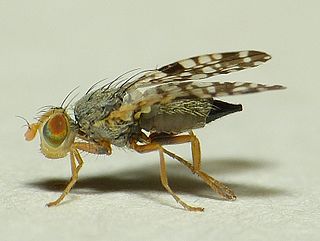
Campiglossa absinthii is a species of fly in the family Tephritidae, the gall flies. The species is found in the Palearctic. Long. : 3-4 mm. The body is ashy grey; the humeral callus and part of pleura yellowish. The mesonotum has three or five more or less distinct brown bands. The legs are sometimes entirely rufous. The wings are opaline with brown spots. The larvae feed on Asteraceae, including Artemisia maritima and Artemisia vulgaris.

Ditaeniella grisescens is a species of fly in the family Sciomyzidae. It is found in the Palearctic.-Long. : 3.5-4 mm.The body is short, narrow, obscure above, with a rather thick yellowish ashy pruinosity. The legs are rufous with tibiae 1 and their tarsi browned. Wings clear: the subcostal cell yellow. For terms see Morphology of Diptera.
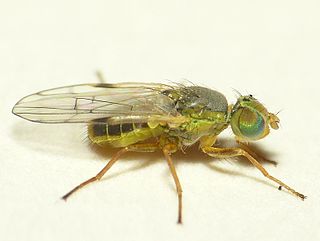
Ensina sonchi is a species of fly in the family Tephritidae, the gall flies. It is found in the Palearctic . The head is light yellow head. Greenish body with yellow villae. The disc of the mesonotum is blackish. Black mesophragm. The legs and halteres are dirty yellow. Wings vitreous or opaline. Abdomen black: tergites tightly yellow at posterior margin with black villi; rufous sternites; Macrochaetes yellowish. Oviscapte black, apex and sides rufous, with fine, yellowish villi. -Long. : 3-3.5 mm. The larvae feed on the flower heads of Asteraceae.
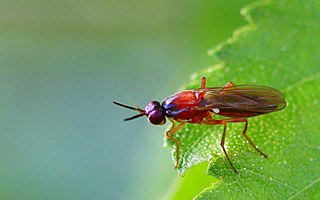
Loxocera albiseta is a species of fly in the family Psilidae. It is found in the Palearctic.The interocular space is red orange or red brown with a black triangle. Scutellum red.The face lacks a black median band.The anterior mesonotum is largely black, the posterior red without black. For terms see Morphology of Diptera.
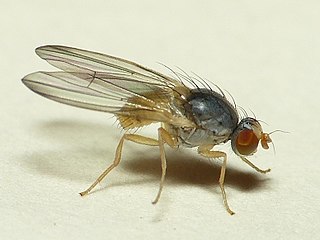
Palloptera ustulata is a species of fly in the family Pallopteridae. It is found in the Palearctic The wings are diffusely shaded brown with a darker tip. The back of the head is largely black.The face and antennae are yellow.The thorax is black with a fairly long whitish pilosity .The legs, tarsi and halteres are yellowish.Long. : 4 mm.The larvae develop under the bark of deciduous trees. It is part of a species complex and difficult to determine with certainty.

Pherbellia nana is a species of fly in the family Sciomyzidae. It is found in the Palearctic




















